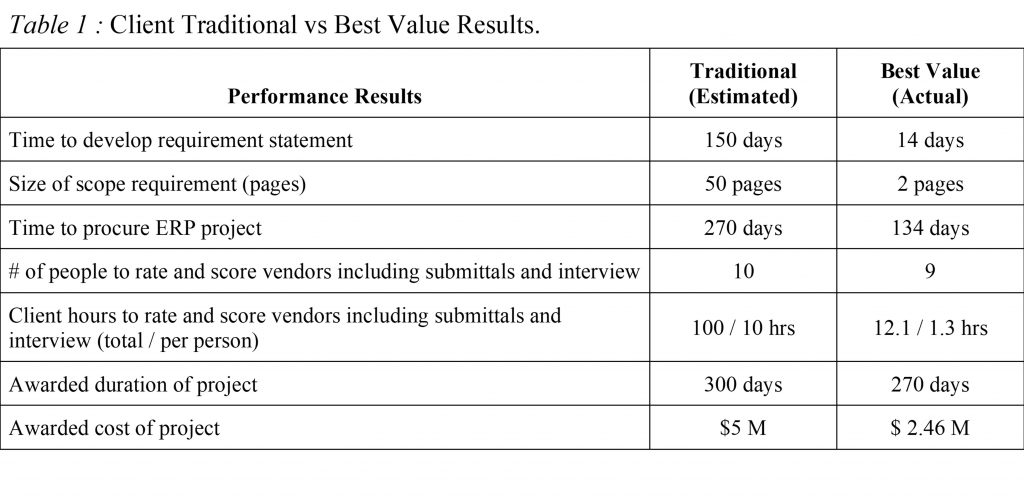
03 Nov The IT Crisis Part 4 | Unravelling the Secret to High Performing ICT Projects
*This is a summary and analysis of the following publication. For full references and research details, please see original publication.
Kashiwagi, I., Kashiwagi, D., & Gambla, L. (2018). Application of the Best Value Approach in Procuring ERP Services in a Traditional ICT Environment. Journal for the Advancement of Performance Information and Value, 10(1), 51-65.
Available at: http://journal.cibw117.org/index.php/japiv/article/view/22
Unravelling the Secret to High Performing ICT Projects
This article is a part of a series of articles unravelling the secret to improving information and communication technology (ICT) project performance. Previous articles have already shown the problem and solution to poor ICT project performance including:
1. Article 1: Chronology and compilation of ICT project performance statistics which have shown to be low for decades.
2. Article 2: Analysis of ICT project complexity, concluding that complexity is caused by insufficient expertise and the solution to complexity is a process which facilitates the identification and utilization of expertise.
3. Article 3: Analysis on current solutions claiming to improve ICT project performance. The results concluded that The Best Value Approach (BVA) was the only proven method through repeated testing and documentation to improve ICT project performance.
The focus of this article will be to walkthrough a recent ICT case study of the Best Value Approach (BVA) to analyze and better understand how the BVA leads to project success.
Case Study: Enterprise Resource Planning software
 This case study is on a Saudi Arabian registered company with more than 40 years of success in training the Saudi Arabian National Guard. The client is a recognized world-class leader and provider of technical services, military training, program management, facilities operation and maintenance, educational and vocational training, and logistics support. The client was looking to outsource the delivery of an ERP software to replace their independent business operation’s current manual and semi-automated systems with a single system.
This case study is on a Saudi Arabian registered company with more than 40 years of success in training the Saudi Arabian National Guard. The client is a recognized world-class leader and provider of technical services, military training, program management, facilities operation and maintenance, educational and vocational training, and logistics support. The client was looking to outsource the delivery of an ERP software to replace their independent business operation’s current manual and semi-automated systems with a single system.
Defining the Client Requirement
The client, based on their traditional method of procuring, would have hired a third-party ICT expert consultant to assist in creating their requirement, this would cost an estimated $500K. The client would then develop a requirement statement which would outline all the specifications and methods needed to accomplish the project (normally 50 pages and would take 150 days to complete). In contrast, using the BVA, the requirement was only 2 pages long and took 14 days to create inclusive of:
- The project outcomes needed—which was a list of 11 functions the client was currently using (i.e. payroll, timekeeping, and vacation planning).
- The project conditions which the ERP system would have to meet such as: locations, number of employees, current software, duration of project, etc.
This was a major shift from their traditional process. The client was no longer expected to be the expert, allowing them to procure without requiring the client to develop a detailed, technical scope requirement. Instead, the client’s time was spent providing the expert vendors the key information they needed and left the method to achieve those outcomes and end solution up to the expert vendor.
Selection Method
The client would normally receive supplier proposals detailing their ERP software and technical specifications. The client’s selection committee would then be required to read, understand compare and rate these technical proposals which could be over 50 pages long. In contrast, the BVA process required each vendor to submit a price and three evaluated documents which demonstrate their capability, including the level of expertise, risk assessment, and value-added options. Each document was no more than 2 pages long, six-pages total. The three evaluated documents did not require any technical expertise to rate and took less than one hour for the selection committee to rate six proposals. The final scores were then automatically calculated based on a formula which normalizes the ratings and takes into account the weights given to each criterion. In making this shift with the BVA, the client moved away from being the expert and forced the vendors to provide simple, project specific metrics which could identify them as experts.
Clarification Phase
The top prioritized vendor was then invited into the clarification phase. During this phase, the vendor relayed their full proposal and plan to the client. The BVA experts assisting the project immediately identified that the vendor was having a challenge adjusting to the change in paradigm. The vendor had operated in the traditional environment for so long that they were not used to being treated like the expert. It was clear that the project plan was not well thought out, but that the vendor was using their company’s standard, template plan which was not adjusted to meet the needs of this specific project. Their plan was technical and difficult to understand with many parts being vague and incomplete in the exact details and deliverables. The plan left key areas undetermined such as the support, demands and participation needed from the client. The client could not understand what would happen at key milestones and if they would be able to meet the demands of the vendor. After a few weeks, the vendor’s personnel became frustrated with the BVA experts, as they were under the impression that this was a complete plan, and no more planning could possibly be done. Eventually, against the advice of the BVA experts, the client was satisfied to move forward, as this was the level of planning, they would normally receive.
During execution of the project, the incomplete planning of the vendor became apparent. Deadlines began to be missed and the client was repeatedly surprised by the vendor with mandatory meetings, deliverables, and misaligned expectations. In order to keep the project a success the client’s project manager was forced to use the majority of his time as the acting project lead, which is something the vendor’s project manager is expected to do. The project ended well but required the client to expend excessive internal man hours and unneeded stress to maintain the project’s schedule.
Project Results
In comparing the client’s results from using the BVA to their traditional process, there were two main areas which were improved during the procurement of the project.
- Defining the Requirement: The ability to procure without requiring the client to develop a full scope requirement. This simplified the size of the scope requirement to 2 pages, a reduction of 48 pages (96% reduction) and saved 136 days (91% savings) and $500K dollars.
- Procurement Process: BVA was an efficient, faster, and lowering costing procurement method. This saved 136 days (50% reduction) in procurement and the reduction of 97 internal manhours (87% savings). Additionally, the vendor’s end proposal was 30 days and $2.5M dollars less than budgeted (10%, 51% savings respectively).
 The Secret to High Performing ICT Projects
The Secret to High Performing ICT Projects
In looking back at this case study, there are two secrets we have found in having a high performing ICT project.
Secret #1: Have a procurement method which can properly identify and utilize the vendor’s expertise. This requires the client to shift the responsibility of expertise to the vendor. As the vendor is assumed to be the expert, this will allow the client to efficiently create their requirement statement and identify the best value for the lowest cost through simple metrics. Amazingly, the less the client tells the vendors the more it requires the vendors to be experts to bid on their project.
Secret #2: Complete and proper planning is required for success. If a vendor is not capable to deliver a simple and complete plan that the client can understand, it is a key indicator that the project is at tremendous risk. It requires true expertise to plan a project. Thus, the most crucial step in a project is the clarification (planning) of a project, this is where the vendor should take control and utilize their expertise the most. The procurement steps can give you incredible savings but to maintain those savings the client must ensure the vendor has a complete plan and can simply explain it.
To learn more about the Best Value Approach, click below:
- Free membership for latest tips and news: https://pbsrg.com/membership/
- For latest books, events, and licensed partners: https://pbsrg.com/resources/
- Latest BVA journal publications: www.cibw117.org/
- Annual Best Value Conference in January: https://bestvalueconference.ksm-inc.com/
- Latest presentations and videos: https://www.youtube.com/channel/UCxBi26nXLDTqG4ZRV6p0iiQ


